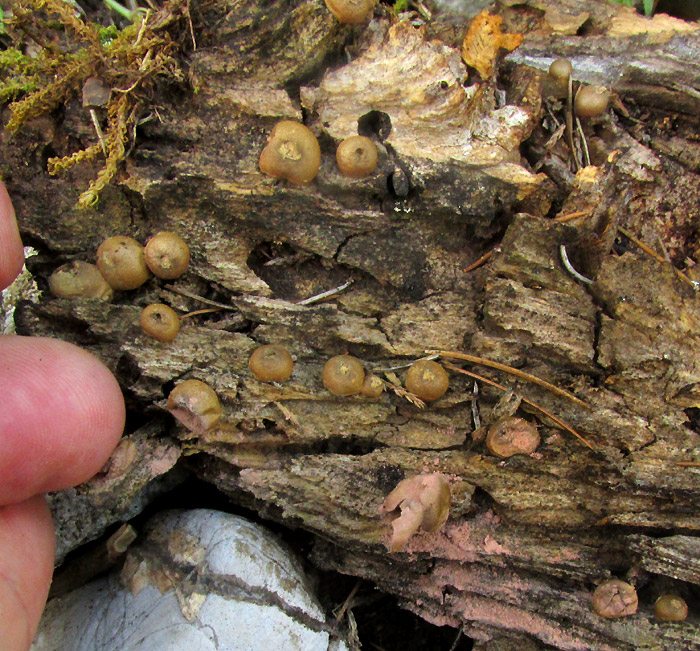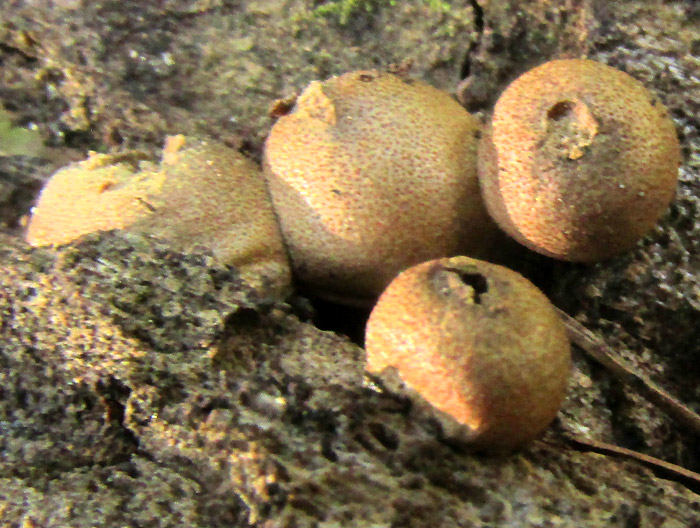Excerpts from Jim Conrad's
Naturalist Newsletter
Entry from field notes dated August 31, 2023, taken in Los Mármoles National Park in the Eastern Sierra Madre mountains, Hidalgo state, MÉXICO, along steeply climbing road heading eastward out of town of Trancas {on maps designated "Morelos (Trancas)"} toward Nicolás Flores; juniper/pine forest on limestone bedrock; elevation ~2,200m (~7,200ft); ~N20.801°, ~W99.254°
STUMP PUFFBALL

On a very rocky, steep, nearly always shaded slope, the above Stump Puffballs, Lycoperdon pyriforme, caught my attention because they were smaller than usual, plus on the semiarid altiplano plain below, I don't see them. In North America usually they're described as 2-3.5cm wide and 2-4.5cm high, and typically young ones display pudgy stems at their bases. However, our largest were only about 0.7cm across, and they lacked stems, which often older ones do. The stems on others create upside-down-pear shapes, thus the species name pyriforme.

Our puffballs are old ones, and central Mexico's long-term drought has left the log our puffballs inhabited hard and dry, so that may account for our individuals being stunted. I've certainly eaten my share or larger ones, but of course only when they were still immature, with white flesh. The white flesh technically is called gleba, which is a solid mass of future spores. Our log's old ones have developed holes in their tops where spores can escape and be dispersed by raindrops and breezes.
Because of the unusually small sizes, could this be a species different from the Lycoperdon pyriforme so commonly, even abundantly, seen in both deciduous and coniferous forests in North America, Eurasia and elsewhere? It's possible. Michael Kuo of MushroomExpert.Com says of the species that "A revision of this group, based on careful study of many specimens, is desperately needed." Probably, he adds, the species isn't even a Lycoperdon. With such a murky understanding of the taxa in North America, there's plenty of room for unknown taxa here in Mexico.
However, as Kuo reminds us, the Stump Mushroom is one of only a few puffballs growing on wood, which helps in identification. A very similar species, the Common Puffball, Lycoperdon perlatum, also occurs here, but it's nearly always on the ground. In the American tropics, Lycoperdon fuligineum is documented farther south of here; it grows on wood and is small like our individuals, but it's a darker color, almost purplish, and the top opening forms less readily and conspicuously.
Naming our puffballs Lycoperdon pyriforme may not be correct, but it seems to be the best name to be applied at this writing. It's the name future researchers will look for when they're studying the matter.
The log's puffballs were so mature and dry that when I squeezed one very slightly its spherical covering crumpled and a cloud of blackish spores puffed through the hole. Because of the general availability of such spores, various cultures traditionally have used them to treat skin scratches and shallow cuts. Many powders can serve the same function, since they greatly increase surface area to which blood platelets can adhere, causing them to clump and form clots, which stops bleeding and leads to scab formation. However, their therapeutic value may amount to more than that. In the 2022 study by Melese Damtew Asfaw entitled "Antioxidant and Antimicrobial activity of Lycoperdon pyriforme fruiting body," it was found that Lycoperdon pyriforme extract "... was effectively able to inhibit the growth of both pathogenic and nonpathogenic bacteria and fungus."
By the way, the genus name Lycoperdon was established in 1700 as the Latinized form of the Greek lykos meaning "wolf," and Greek perdesthai meaning "to fart" -- wolf fart. In Mexican Spanish the puffballs are likely to be called pedos de coyote, or "coyote farts."